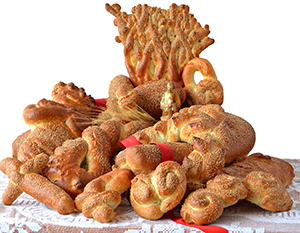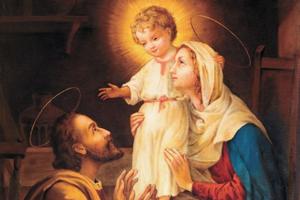In the Spirit of Saint Joseph’s Day, Free Bread for All
The Saint Joseph’s Day Table was born out of a Sicilian tradition that the people would honor St. Joseph after he saved them from a severe famine.


This saddens me not only because I always look forward to the seemingly-endless array of non-meat dishes and the ever-changing cast of characters who come in, eat and leave, and then are followed by another wave of guests, but because my family’s bakery, Di Camillo Bakery, which is celebrating its 100th year of operation, is going to get stuck with dozens, if not hundreds, of loaves of traditional Saint Joseph’s Day breads.
(For more on the tradition of the Saint Joseph’s Day Table tradition and the different types and shapes of breads, please see this article.)
What do you do in this situation? My father, Thomas Di Camillo, senior vice president of production and master baker: “Why don’t we just give the bread away?”
His reasoning has centuries of sense behind it: the Saint Joseph’s Day Table was born out of a Sicilian tradition that the people would honor St. Joseph — the greatest saint next to the Blessed Virgin Mary herself — since he had saved their land from a severe famine. After the famine, the Sicilian people (though this devotion quickly spread to the rest of Italy) opened their doors and homes to anyone — and the key word here is anyone — who needed food March 19. In its most egalitarian version, a St. Joseph’s Day Table meant you could walk into any — or many — different homes and eat as much as you wanted (especially if you had gone hungry during those last, seemingly-endless days of winter) without shame or explanation.
“In Italy,” said my father, “March 19 is already springtime and the first greens — cardoons, dandelions — are coming up. So the people do have the first signs not only of spring-rebirth but of fresh greens to eat. Sharing these (usually breaded) greens became a tradition that came to America when so many Italian and Sicilian people left Europe.”
Actually, Saint Joseph’s Day came early here for some Niagara County businesses. According to Matthew Di Camillo, my cousin and our general manager, “All restaurants have had to close do to the virus, except for pickup orders, so I started calling them and asking if they could use our St. Joseph’s Day breads, since all the churches, church halls, Knights of Columbus and familial St. Joseph’s Day tables had been canceled.”
So today, when we honor the man whom Holy Scripture itself calls “Righteous,” Di Camillo Bakery decided to give away free loaves of the bread, shaped and baked in his honor.
The irony of this good work — in which our company was joined by others, including our “competition” at The Little Bakery (née Trusello’s Bakery), Casa Antica Restaurant and others (see the Niagara Gazette piece), is one of crowd control — you cannot have too many people in the store at a given time due to the spread of the virus. But my cousin Matthew said, “We took ‘crowd control’ into account early and have been able to get people in and out of our stores relatively quickly.”
Another irony in this “Time Of Plague,” as the late poet Thom Gunn might have called it, is that what was a communal coming together — to break bread at an open-door-policy setting, whether it be a home or church hall — has now morphed into a family gathering.
“This year,” my father said, “Saint Joseph’s Day dinners will be celebrated with small, intimate family gatherings. But since even the smallest loaf of St. Joseph’s Bread is too big for one person, that bread will have to be passed around the table and broken off by another family member. Hence that term ‘breaking bread together.’”
I’ve mentioned elsewhere the traditional shapes of Saint Joseph’s Day Bread and their meanings:
- The Bambino is the smiling baby Jesus.
- The Sheaf of Wheat represents the first harvest of springtime.
- “Saint Joseph’s Beard” — a reminder that, in some traditions, St. Joseph was an old man.
- The Latin Cross. Pretty self-explanatory but when you think about it. Tonight that cross is perfect for a family of four, as each person gets one part of it.
- St. Joseph’s Staff or Cane. When you turn it upside-down and backward, the cane resembles a “J” for Joseph. Another reminder of St. Joseph in his old age, but also a shepherd’s staff (cf. Psalm 23).
- The Heart. Representative of the Sacred Heart of Jesus and the Immaculate Heart of Jesus, certainly, but also of St. Joseph’s own big heart.
- The Crown of Thorns. During this season of Lent, always a reminder of the Passion of Jesus.
- Saint Joseph’s purse. A reminder to give alms to the poor especially during Lent — though we know from the Gospels that St. Joseph himself was poor.
- St. Joseph himself — a bread statuette of Saint Joseph.
- The fish — an early symbol of Jesus, and a reminder of the abstaining from meat during the Lenten season.
- The Figure Eight. Actually, this is the symbol of “infinity,” symbolizing God with no beginning and no end.
Saint Joseph’s Day and St. Patrick’s Day are practically “high holy days” in western New York, since there was so much intermarriage between Italians and Irish. This year, both have been muted by the coronavirus. But in the true spirit of St. Joseph, our family’s bakery wanted to honor his memory — and on a personal level, to pray for his intercession to end the COVID-19 pandemic.
In Memoriam Anita Josephine Di Camillo, born this day in 1912. Ite Ad Ioseph!
- Keywords:
- st. joseph

















